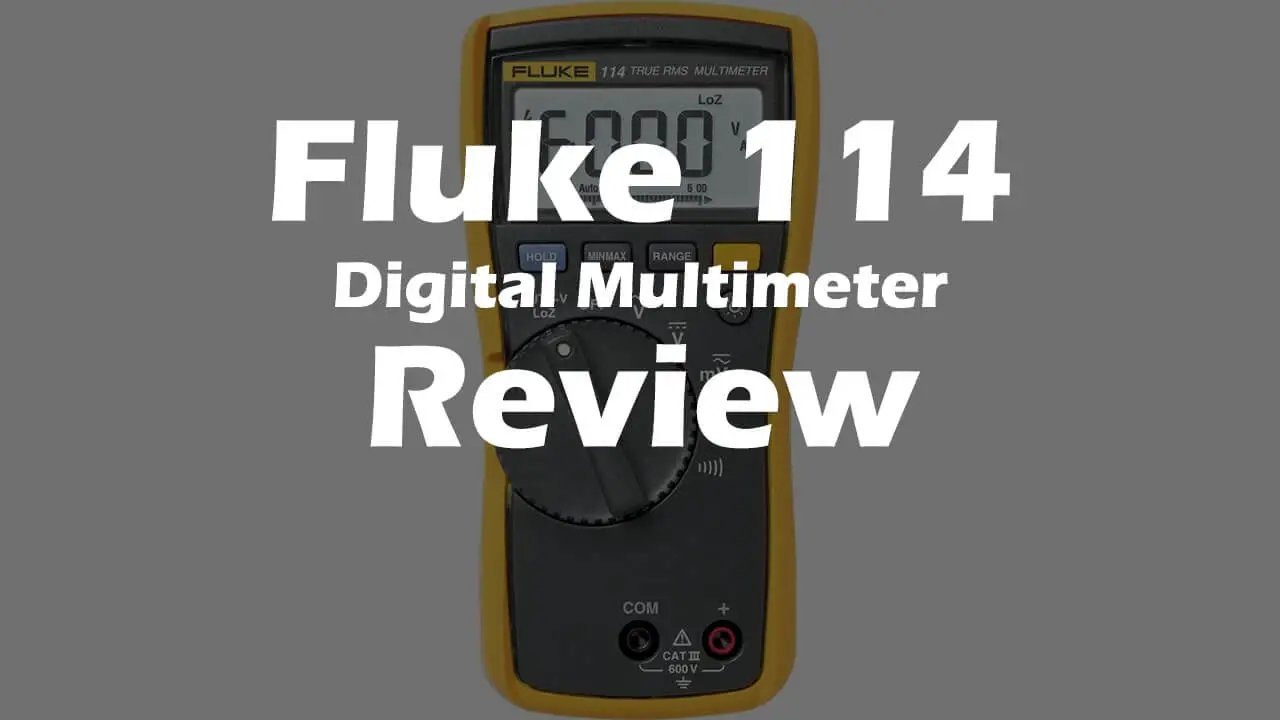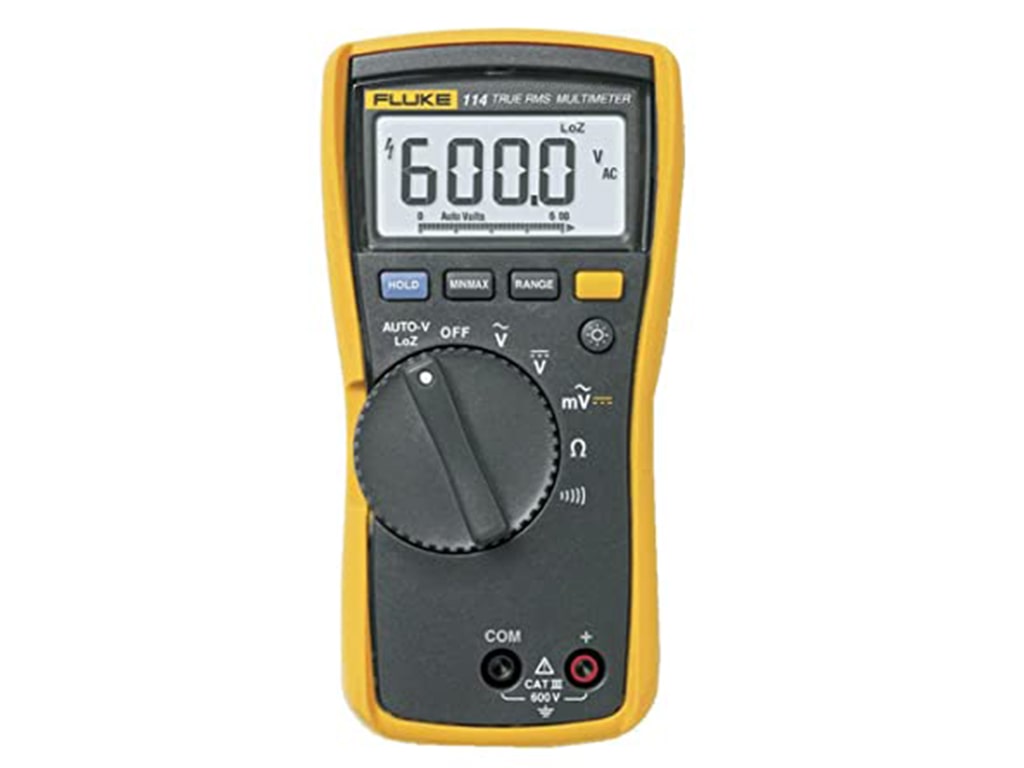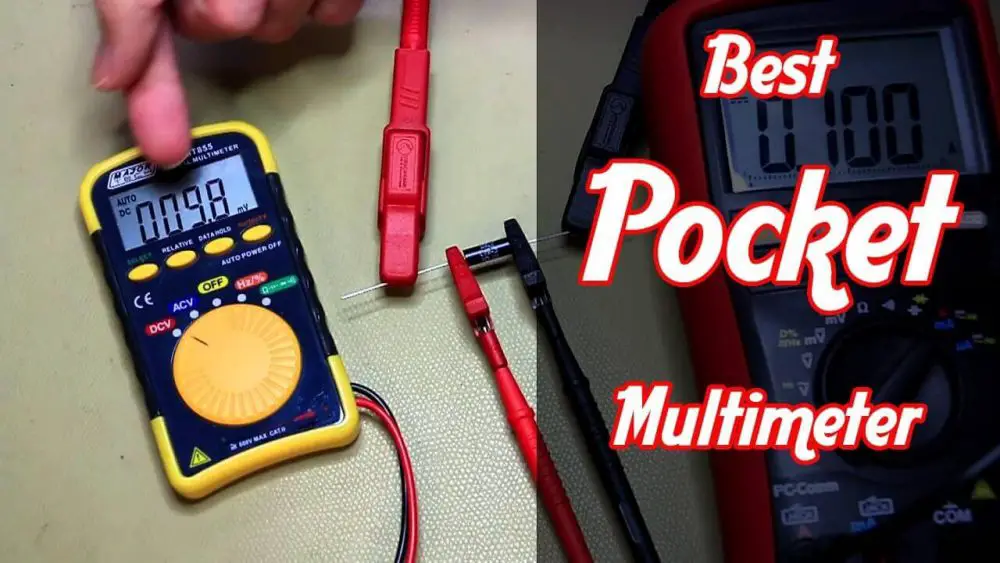Fluke 114 Multimeter Review-Fluke Electronics Multimeter
Fluke 114 digital multimeter is designed for single-handed operation. Fluke 114 is a True RMS digital multimeter. It is an excellent troubleshooting tool for its auto-volt range. It can automatically switch to measure A/C or D/C voltage when working with any appliances. The Low impedance function helps to identify unknown voltage and prevent false readings. The Fluke 114 multimeter displays True RMS voltage and current with 6000 count resolutions, and it can also check frequency, continuity and resistance. A large white LED backlight helps to work in darker places. Fluke 114 multimeters provided accuracy and tested for safe use with CAT III 600Volts.
What’s in the box:
- Fluke 114 Electrician’s MultimeterRubber holster
- 9V battery
- Test leads
- Manual online
Table of Contents
Fluke 114 Quick Review
- True RMS multimeter
- Auto-range, automatic AC/DC voltage selection
- LoZ helps prevent false readings due to the unknown voltage
- Large LCD backlit helps to work in a poorly lit area.
- Easy battery shelving
- Resistance and continuity
- Min/Max/Average helps in recording average current and fluctuation.
- CAT III safety rated 600V.
- The probe holster at the back helps to work with both hands.
- Auto-ranging and manual-ranging are both available.
- Size= 6.6″(1.67cm) x 3.3″ (8.4cm) x 1.8″ (4.6cm)
- Weight= 1.2 lbs (550gm)
Fluke 114 Basic Features:
Today we are going to look at one of my all-time classic multimeters. That is Fluke 114 my all-time favourite multimeter. I have owned many multimeters in my life this one is sort of top the list for me because it does everything.
I like them as well they are also brilliant meters but for me, this has always just been the right sort of size.
I recently acquired another fluke very similar to the Fluke 117 being my current favourite, and that is the Fluke 114 digital multimeter.
What are the key differences are between these two meters for all intents, they look kind of the same, and I have just been inside the Fluke 114. I think a lot of the limitations come in the actual hardware lockouts, and not necessarily in the software like you’ll see this has got current and then the volts alert, but if you have a look at the current from the diode, capacitance amps A/C amps D/C a second function is Hertz, capacitance is not available on this meter but again, this is a mechanical lockout.
Electrically both meters are probably very very similar in the way, that, they function so what you will notice immediately between the two is they both start with the auto-volts alloy z or the impedance auto voltage so that’s good for getting rid of ghost voltages.
A/C voltage
We have got volts A/C both have the volts A/C. One thing you will notice when you turn
Fluke 114 ON’ they do seem to have different firmware versions, and all the test itself here where this has got the Hertz as a second function this one does, not, in fact, have that option.
D/C Voltage
Another function you have got is volts D/C we have them almost the same then you have got your millivolts A/C second function millivolts D/C.
Low Impedance
You have got your sort of low impedance or low ohms up to 600 ohms and together with this is your continuity tester.
Diode test
There is no diode test and no capacitance test no amps A/C and your hertz for your A/C amps and no amps D/C, and no-volt alert sensors like in Fluke 117.
But otherwise still decent now so far as what we mentioned about electrically they seem very similar is when we were working inside the 114. We noticed that already it had the third terminal it just didn’t have on the casing the third terminal but the contact was there and the screw point standoff was there everything was there and then we noticed on the switch that it had sort of two little pins that stop it from proceeding any further so electronically, I think it’s the same board, probably different software on the two meters but for all intents and purposes the same physical hardware.
True RMS multimeter
Fluke 114 multimeter is also a true RMS tester so both of them will sort of getting you the same results if you are just doing A/C and D/C Ohms etc. But if you need currents so this will not work.
Fluke 114 multimeter is a great electrical multimeter alongside a current clamp so that you can get the contemporary side of things done, and then you will be good to go with a 114 and a pleasant little current clamp meter or an A/C clamp meter. You would be able to do good for most tasks, and if you do work D/C like battery arrays, inverters etcetera then get an A/C, D/C clamp meter.
THING I LIKE ABOUT IT
Compact multimeter
Single-handed operation
Rugged and durable
Accurate and reliable
Min/Max/Average
The display is not very bright
THINGS I DIDN’T LIKE
The display is not very bright
Diode test not available
Frequently Asked Questions:
Both the Fluke are the same except current test functions that are frequency, capacitance, Diode test amps and milliamps are available in Fluke 117 only.
AUTO-V is the function you can measure both A/C and D/C circuits, and it will display results accurately on screen. Auto-volt can detect the unknown or ghost voltage in the circuit. The LoZ function, which is the low impedance of the meter, cancels the ghost voltage accidentally found in the circuitry.
Conclusion
In this article, we have discussed Fluke 114 digital multimeter which is an electrician multimeter but it is not an electronic multimeter. But all the basic functions are the same. Its durability and reliability are confirmed its quality. Customer reviews are good. This is the best multimeter for DIY users and commercial use. All the features are excellent. Functionality is accurate. So far best multimeter, except A/C current test, diode test, and capacitance is not available.
Related posts:
Fluke 117 Digital Multimeter True RMS





